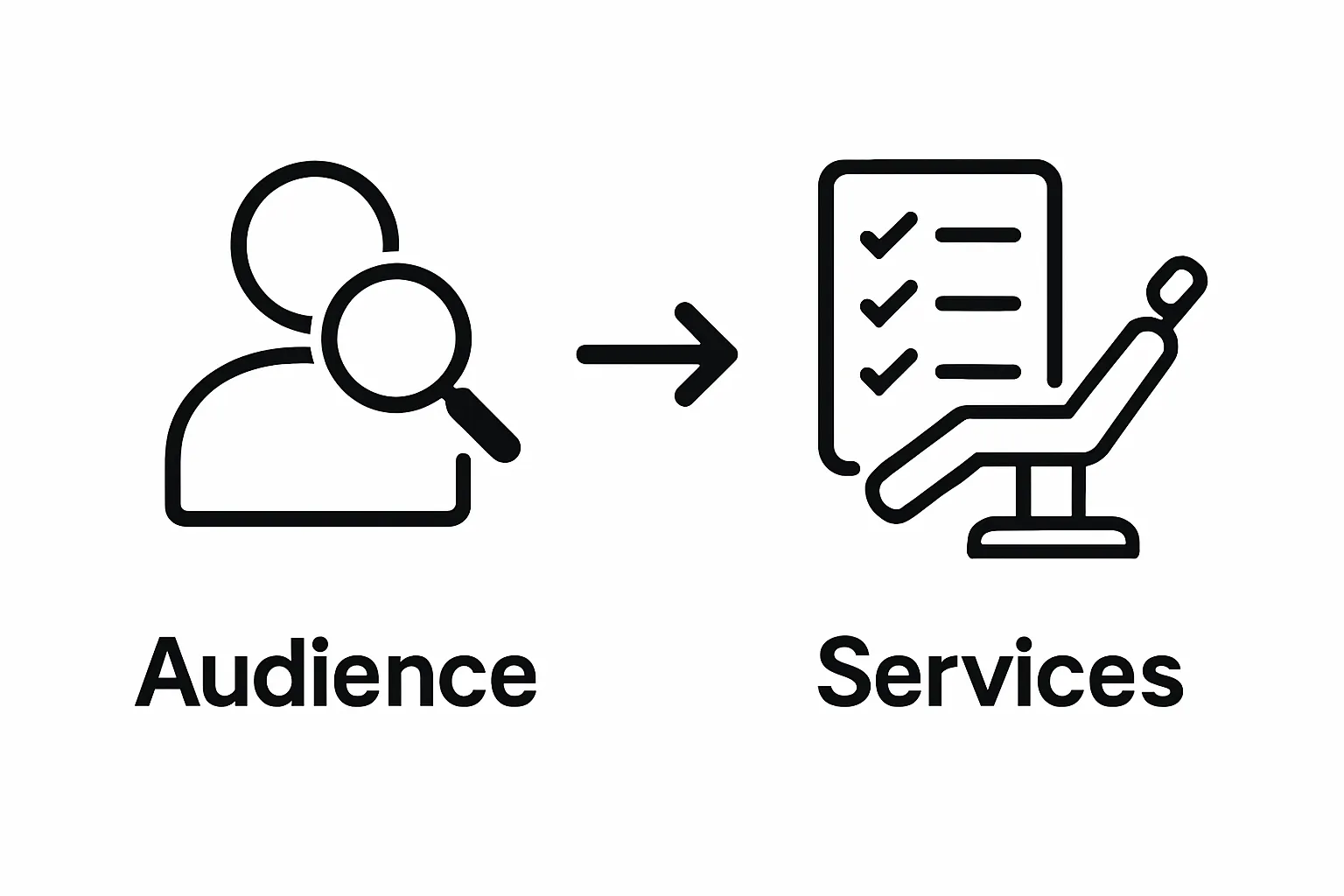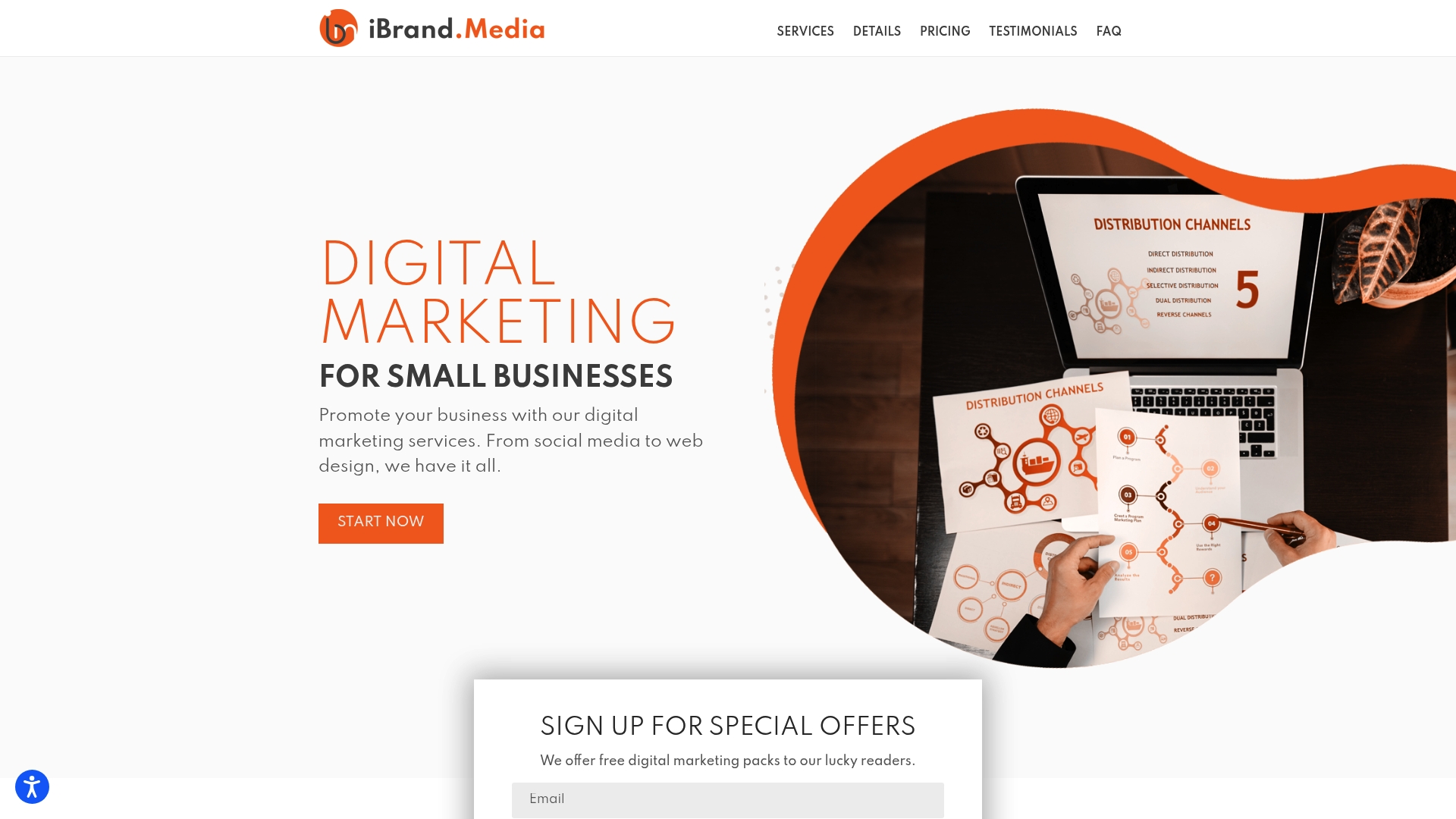Dental practices used to rely on word of mouth and neighborhood flyers. Now, over 70 percent of patients start their search for a new dentist online. Surprising, right? Most dentists still pour money into traditional ads without realizing that a strong digital presence attracts more patients than a new billboard ever could.
Table of Contents
- Step 1: Identify Your Target Audience And Services
- Step 2: Create An Engaging Website For Your Practice
- Step 3: Optimize Your Website For Search Engines
- Step 4: Leverage Social Media To Connect With Patients
- Step 5: Monitor And Adjust Your Marketing Strategies
Quick Summary
| Key Point | Explanation |
|---|---|
| 1. Define your target audience clearly | Identify specific patient demographics and service needs to tailor your marketing effectively. |
| 2. Create a user-friendly website | Ensure your website is visually appealing and navigable to convert visitors into patients easily. |
| 3. Optimize for local search engines | Integrate relevant keywords and optimize your Google Business Profile to improve local visibility. |
| 4. Engage patients on social media | Build community by sharing valuable content and interacting with patients on platforms like Facebook and Instagram. |
| 5. Continuously monitor marketing strategies | Use analytics to track performance and adjust strategies as needed based on patient engagement and acquisition rates. |
Step 1: Identify Your Target Audience and Services
Successful dental practice online marketing starts with understanding precisely who you serve and what unique services you offer. Defining your target audience and services is the foundational strategy that will drive every subsequent marketing effort.
Begin by creating a detailed patient persona that goes beyond basic demographics. Consider factors like age ranges, income levels, dental health needs, and lifestyle characteristics. Are you a family dental practice focusing on pediatric and general care? Or do you specialize in cosmetic dentistry targeting professionals seeking aesthetic improvements? Your marketing messages must speak directly to these specific patient groups.
Learn more about targeted marketing strategies can help you refine your approach. Understanding patient motivations means diving deep into their pain points. A young professional might prioritize teeth whitening and quick appointment scheduling, while an older patient could be more concerned with comprehensive dental health management and insurance coverage.
Document your practice’s unique service offerings with precision. List out every procedure, from routine cleanings to specialized treatments like dental implants or orthodontic services. Highlight what makes your practice different: advanced technology, personalized care approaches, multilingual staff, or convenient appointment scheduling. These distinctive elements become powerful marketing differentiators.
Verify your audience identification by checking these key indicators:
- Patient demographic data matches your defined persona
- Marketing messages generate engaged responses
- Appointment inquiries align with your targeted service offerings
- Website analytics show increased relevant traffic
Remember that audience identification is not a one-time task but an ongoing process. Regularly survey patients, analyze your practice’s performance metrics, and remain adaptable. Your target audience and service positioning will evolve, and your marketing strategy must evolve with them.
Below is a checklist to help verify if you have successfully identified your target audience and defined your dental practice’s unique services.
| Verification Criteria | What to Check For |
|---|---|
| Patient demographic data matches target persona | Your patient profiles align with defined age, needs, lifestyle |
| Marketing messages generate engaged responses | Ads or posts receive appropriate interest from desired groups |
| Appointment inquiries align with targeted services | Patients request services you want to highlight and promote |
| Website analytics show increased relevant traffic | Web visitors reflect your target demographic or service |
| Ongoing adaptation based on surveys & metrics | Regularly update strategies from feedback and data |

Step 2: Create an Engaging Website for Your Practice
Your dental practice website serves as your digital front door, welcoming potential patients and showcasing your professional expertise. A well-designed website transforms casual online visitors into committed patients by delivering a compelling, informative, and user-friendly digital experience.
Explore essential website design practices that can elevate your online presence. Start by selecting a clean, modern design that reflects your practice’s professionalism. Prioritize mobile responsiveness, ensuring your website looks and functions seamlessly across smartphones, tablets, and desktop computers. Patients often search for dental services on mobile devices, so a responsive design is non-negotiable.
Content is king in creating an engaging website. Develop clear, concise pages that explain your services, introduce your dental team, and highlight your practice’s unique qualities. Include high-quality professional photographs of your staff and office environment to build trust and provide a welcoming visual preview. Professional headshots and brief professional biographies help humanize your practice and establish credibility.
Integrate critical functional elements that enhance patient experience. Implement an online appointment booking system that allows patients to schedule consultations directly through your website. Include a comprehensive services page detailing treatments, pricing transparency where possible, and patient education resources. Add patient testimonials to build social proof and showcase your practice’s successful outcomes.
Verify your website’s effectiveness through these key indicators:
- Intuitive navigation with clear menu structures
- Fast page loading speeds across all devices
- Easy-to-find contact information
- Mobile-friendly design and functionality
- Visible call-to-action buttons for appointment scheduling
Consider professional web design services specializing in healthcare websites if you lack technical expertise. While template-based solutions offer affordability, a custom design can more precisely communicate your practice’s unique brand and patient care philosophy. Your website is an investment in attracting and retaining patients, so approach its development with strategic thoughtfulness and professional standards.
Use this checklist to evaluate if your dental practice website includes all essential elements for a user-friendly and effective patient experience.
| Website Feature | Description |
|---|---|
| Intuitive navigation | Clear menus for easy page access |
| Fast page loading speeds | Website loads quickly on all devices |
| Easy-to-find contact information | Phone number, address, and email are prominent |
| Mobile-friendly design | Website adapts to smartphones and tablets |
| Visible call-to-action buttons | Prominent links for booking appointments or contacting practice |
| Online appointment booking system | Enables direct scheduling by website visitors |
Step 3: Optimize Your Website for Search Engines
Search engine optimization transforms your dental practice website from an online brochure into a powerful patient acquisition tool. By implementing strategic SEO techniques, you ensure potential patients can easily find your practice when searching for dental services in your local area.
Discover essential SEO optimization strategies that can dramatically improve your online visibility. Start by researching local dental keywords patients actually use. Terms like “family dentist near me,” “teeth whitening [your city],” and “emergency dental care” should be naturally integrated into your website content. Focus on creating informative, locally relevant content that answers common patient questions about dental procedures, oral health, and your specific services.
Technical optimization is equally critical. Ensure your website loads quickly on all devices, as search engines prioritize fast-loading sites. Implement schema markup specific to dental practices, which helps search engines understand your content more precisely. This structured data can enhance your search result appearances, displaying additional information like your practice hours, services, and patient reviews directly in search results.
Local SEO requires specific attention for dental practices. Claim and optimize your Google Business Profile with accurate contact information, service details, and high-quality practice photos. Encourage satisfied patients to leave genuine reviews, as these significantly impact your local search rankings. Consistency is key: ensure your practice name, address, and phone number are identical across your website, Google Business Profile, and other online directories.
Verify your SEO optimization through these critical indicators:
- Website appears in top 3 local search results for key dental services
- Google Business Profile displays complete and accurate information
- Website load time is under 3 seconds on mobile devices
- Multiple positive patient reviews are visible online
- Website content naturally incorporates relevant local and service-specific keywords

Remember that SEO is an ongoing process. Search engine algorithms constantly evolve, so regularly update your website content, monitor your performance using tools like Google Analytics, and stay current with digital marketing trends. Patience and consistent effort will gradually improve your online visibility and attract more potential patients to your dental practice.
Here is a checklist to confirm your SEO optimizations are in place and effective for boosting your dental practice’s online visibility.
| SEO Optimization Criteria | What to Verify |
|---|---|
| Top 3 local search results for key services | Website appears prominently for major dental service queries |
| Google Business Profile accuracy & completeness | All practice info, hours, and photos are up-to-date |
| Website load time under 3 seconds (mobile) | Test speed with online tools to ensure quick mobile access |
| Multiple positive patient reviews | Genuine reviews are visible and regularly updated |
| Relevant local and service-specific keywords used | Content naturally fits common terms for location and specialties |
Step 4: Leverage Social Media to Connect with Patients
Social media transforms your dental practice from a clinical service into a community-focused healthcare partner. By strategically using digital platforms, you create opportunities to educate, engage, and attract potential patients while building lasting relationships with your existing client base.
Explore effective social media strategies that can help you connect meaningfully with your target audience. Select platforms where your target patients are most active. Facebook and Instagram typically work best for dental practices, offering visual storytelling opportunities and robust demographic targeting. Create a consistent posting schedule that balances professional content with approachable, human-centered messaging.
Develop content that provides real value to your audience. Share educational posts about oral health, behind-the-scenes glimpses of your practice, patient transformation stories, and quick dental care tips. Use a mix of formats like infographics, short videos, patient testimonials, and live Q&A sessions to keep your content dynamic and engaging. Remember that potential patients want to see expertise combined with genuine compassion.
Encourage patient interaction by making your social media channels feel welcoming and responsive. Promptly answer comments and direct messages, address patient questions professionally, and showcase your practice’s personality. Consider running occasional contests or patient education campaigns that incentivize engagement. Highlight your team members to humanize your practice and help patients feel more comfortable before their first visit.
Verify your social media effectiveness through these key performance indicators:
- Consistent monthly follower growth
- Active engagement rates (likes, comments, shares)
- Increasing website traffic from social platforms
- Positive patient interactions and comments
- Measurable appointment bookings attributed to social media
Understand that social media marketing is a marathon, not a sprint. Consistent, authentic communication builds trust over time. Invest in quality content, maintain a professional yet approachable tone, and view these platforms as relationship-building tools rather than mere advertising channels. Your goal is to transform casual social media browsers into informed, confident patients who see your practice as a trusted healthcare partner.
Step 5: Monitor and Adjust Your Marketing Strategies
Successful dental practice marketing requires continuous evaluation and strategic refinement. Monitoring your marketing efforts is not a one-time task but an ongoing process of understanding what works, what doesn’t, and how to improve your patient acquisition strategies.
Explore comprehensive marketing strategy development to gain deeper insights into performance tracking. Start by implementing robust analytics tools across all your digital platforms. Google Analytics, social media insights, and specialized dental practice marketing software can provide comprehensive data about your online performance. Track key metrics like website traffic, patient inquiry rates, appointment booking conversions, and the sources of your most valuable patient leads.
Dive deep into your data to understand patient behavior patterns. Analyze which content generates the most engagement, which marketing channels bring the most qualified leads, and how potential patients interact with your online presence. Look for trends in patient demographics, service preferences, and interaction points. This granular understanding allows you to create more targeted, effective marketing strategies that speak directly to your ideal patient base.
Be prepared to make decisive adjustments based on your insights. If your social media content about pediatric dentistry generates more engagement than general dental health posts, pivot your content strategy accordingly. If Google Ads for teeth whitening services are delivering better conversion rates than general dental check-up advertisements, reallocate your marketing budget to maximize these high-performing channels.
Verify your marketing strategy optimization through these critical indicators:
- Consistent month-over-month improvement in key performance metrics
- Increased patient inquiry and conversion rates
- Reduced customer acquisition costs
- Higher engagement across digital marketing channels
- Positive return on marketing investment
Remember that marketing is an adaptive process. What works today might not be as effective tomorrow. Stay curious, remain flexible, and view each data point as an opportunity to refine your approach. Your willingness to learn, adjust, and experiment will ultimately determine the success of your dental practice’s online marketing efforts.
Use the table below to monitor key performance indicators that measure the effectiveness of your ongoing dental marketing strategies.
| Performance Indicator | What It Shows |
|---|---|
| Month-over-month metric improvement | Positive growth in website visits, bookings, or patient inquiries |
| Increased inquiry & conversion rates | More patients contacting and scheduling appointments |
| Reduced acquisition costs | Lower spending to gain each new patient |
| Higher engagement on channels | Better interaction rates across website and social media |
| Positive return on investment (ROI) | Marketing efforts are delivering measurable business benefits |
Ready to Transform Your Dental Practice Marketing Results?
If you feel overwhelmed by the challenge of building an engaging website, optimizing for local SEO, and keeping up with the constant changes in digital marketing, you are not alone. Many dental practices struggle to create personalized marketing strategies that attract the right patients and grow local visibility. The article you just read highlights the essential steps to success, from understanding your audience to real-time performance tracking. Now, it is time to turn these actionable insights into real growth with help from experienced professionals. Discover more industry-specific solutions or go straight to our website ibrand.media to see how we can help.

Take control of your practice’s future. At ibrand.media, our experts deliver tailored digital marketing, including powerful SEO enhancement, professional web design, and full social media management designed for dental practices like yours. Connect with us today to request a custom plan and see measurable local results. Your next wave of patients is already searching for you online—let us make sure they find your practice first!
Frequently Asked Questions
What are the first steps in developing an online marketing strategy for a dental practice?
Successful dental practice online marketing begins with identifying your target audience and defining the unique services you offer. Start by creating detailed patient personas based on demographics, dental health needs, and lifestyle characteristics.
How can I ensure my dental practice website is engaging for potential patients?
To create an engaging website, use a clean and modern design, prioritize mobile responsiveness, and focus on high-quality content. Incorporate an online appointment booking system, detailed service information, and patient testimonials to enhance the user experience.
What SEO strategies should I implement for my dental practice website?
Focus on local SEO by researching relevant dental keywords, optimizing your Google Business Profile, and ensuring your website loads quickly. Use schema markup and create informative content to drive local traffic to your site while improving search engine rankings.
How can social media help grow my dental practice?
Social media allows you to connect with potential patients and build community relationships. Share valuable content, engage with your audience, and showcase your practice’s personality. Regular interaction and valuable posts can convert casual browsers into committed patients.
Recommended
- Understanding Why Dentists Need Social Media | Ibrandmedia
- Top Benefits of Local Marketing for Small Businesses 2025 | Ibrandmedia
- Boost Your Revenue: Increasing Local Sales Online | Ibrandmedia
- Top Local Online Marketing Strategies for 2025 Success | Ibrandmedia
- SEO for Dentists: Boost Your Practice with Proven Strategies

Recent Comments